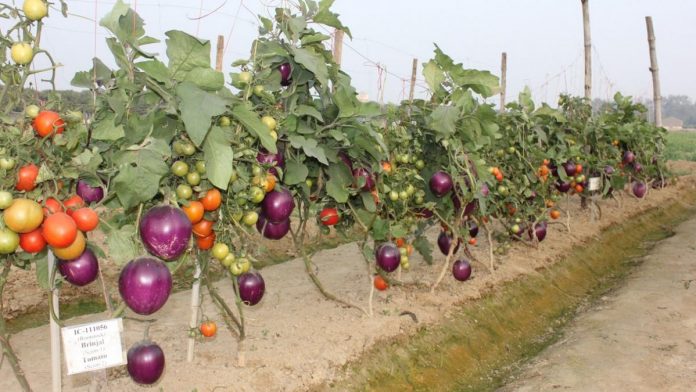Is it brinjal or tomato? No, it’s ‘Brimato’, just like ‘Pomato’ grafted by Varanasi scientists

Scientists at the Indian Council of Agriculture Research’s Indian Institute of Vegetable Research (ICAR-IIVR) in Varanasi have successfully developed a technique to cultivate a plant that yields both brinjals and tomatoes. They have named it ‘Brimato’.
The breakthrough will allow the cultivation of more vegetables in smaller spaces in semi-urban and urban areas, such as in kitchen gardens. This is expected to improve the availability of vegetables and reduce the input cost on labour, water and chemicals etc.
Each ‘Brimato’ plant is estimated to yield 3-4 kilograms of brinjal and 2-3 kilograms of tomato.
The IIVR has previously successfully grafted a plant named ‘Pomato’, which yields a combination of potatoes and tomatoes.
Brimato was developed through dual or multiple grafting, wherein two or more ‘scions’ of the same plant family are grafted together to harvest more than one vegetable from a single plant. The parent plants of the Brimato are an enhanced brinjal hybrid known as ‘Kashi Sandesh’ and an improved variety of tomato ‘Kashi Aman’, which were grafted into the brinjal rootstock known as IC 111056.
How Brimato was developed
The scientists behind Brimato explained that the grafting was carried out when brinjal seedlings were 25-30 days old, while the tomato ones were 22-25 days old.
Grafting is a technique of joining together plant parts by means of tissue regeneration. A portion of one plant is placed into or on a stem, root, or branch of another. The part that provides the root is called the stock, whereas the added piece is called the scion.
In the case of Brimato, soon after grafting, the seedlings were kept in controlled atmospheric conditions. Temperature, humidity and light were kept at an optimum level for 5-7 days, and then the seedlings were placed in partial shade for a similar duration. Thereafter, the grafted plants were transplanted in the field 15-18 days after the initial grafting operation.
The benefits
According to Dr T.K. Behera, director of ICAR-IIVR, this new method of producing two vegetables from the same plant will help meet current nutritional and productivity challenges arising out of a lack of space for cultivation.
“Earlier, this was restricted to flowers or fruits, but we have expanded it to vegetables. Brimato will be very helpful in terms of nutritional security — it is the best method to ensure domestic nutrition as prices of vegetables increase. It also reduces costs and residual toxicity, with low chemical presence in crops,” he told ThePrint.
“Brimato can be developed merely at a cost of Rs 10-11, and a month in duration. With an adaptation of this to a large commercial scale, which is being tried, the plant availability price will also reduce to Rs 4-5 per plant. Moreover, scientists are also planning to develop many such varieties with working on grafting of other vegetables together too,” Behera said.
He added that the technique that developed Brimato will also be a promising tool for increasing crop tolerance to biotic and abiotic stresses, such as adverse climatic conditions — it can withstand excessive waterlogging as well as drought-like scenarios.
Source – ThePrint